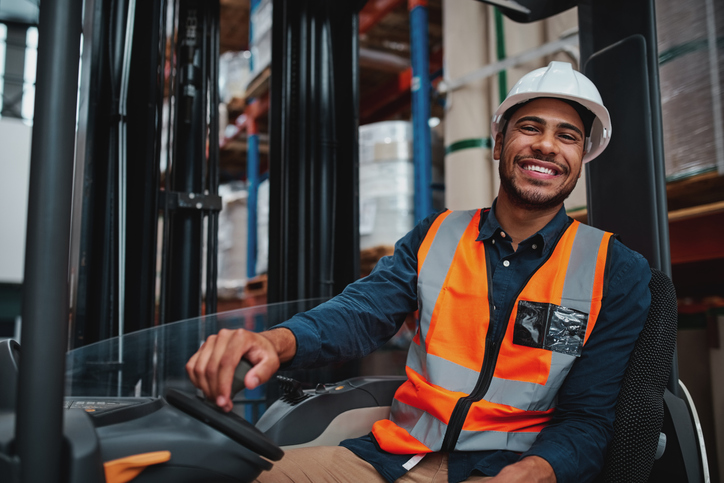Material handling is a process of moving, storing, and protecting goods. Over the years it has evolved and changed. Hence, it’s worth observing in what direction the industry is heading. Below you may read about 6 major trends in the material handling industry.
1. Automation
Modern warehouses turn towards the automation of processes. Growing client base and the demand for fast shipping require operations that are accurate and swift. Consequently, it’s not surprising that distribution centres invest more and more in robots. Robots can be employed to do a variety of tasks, including picking, packaging, batching, transportation, fulfilment, security, and inspection. Their use can also contribute to the most wanted effectiveness and cost savings. The potential for human error is greatly reduced, too.
Automated guided vehicles (AGV) and automated mobile robots (AMRs) are rising in popularity as they do not require costly adjustments of the floor plan and infrastructure compared to automated storage and retrieval systems (ASRS).
Drones are extensively used to support shipping and delivery, scan barcodes and RFID taggings, operate in hard-to-reach locations, gather aerial inventory scans and more.
Cobots are implemented to make machines work hand in hand with humans. They are collaborative robots designed to work together with people to improve the efficiency of operations. The most popular warehouse cobots aim to reduce unnecessary walking by offering transportation, freeing up workers to concentrate on other duties that generate income. Cobots can improve warehouse productivity by taking over repetitive, undesirable activities. They support the strive to optimise the workload. The clue is to create a collaborative working environment where people and robots complement each other. Robots prove themselves in certain contexts, while humans are better at other tasks.

2. Modular solutions
In a warehouse environment, it is often difficult to predict future requirements and the equipment needed. As a result, modular systems enjoy popularity because they offer the opportunity to design the desired solutions in a flash. Modular systems are like LEGO blocks - you can combine all elements as you like to receive the required outcome. Such flexibility and customisation are greatly appreciated by modern warehouses and distribution centres.
3. Digitalisation
Another strong trend is digitalisation and here the Internet of Things (IoT) is worth mentioning. It is a network of devices interconnected with sensors, software, and other technologies to collect and monitor data. It is a key technology driving current warehouse automation trends. It enables the connection and coordination of all moving pieces of the warehouse environment, and thus full optimisation of procedures.
4. Improved safety
The material handling industry values safety. Distribution centres can be dangerous places to work in. The risk of accidents and injuries is always present. That is why the strive for ultimate safety is never over. Hazardous tasks are being happily replaced by automation safeguarding the employees and reducing warehouse traffic. Robots reduce the need for human labour in precarious conditions and achieve predictable movements that create fewer occasions for accidents. At the same time, even more reliable power transmission solutions are developed to protect the employees and form more friendly working conditions. MEGASYNC Titanium, Megalinear QST, Megalinear P3.3, Rollpower, and Megalinear GW, for instance, significantly reduce the noise nuisance and ensure the safety of operations.

5. Higher efficiency
The modern world poses new challenges for all of us and the material handling industry is not an exception. The warehouses work harder and harder to meet robust e-commerce requests and same-day shipping trends. Higher efficiency is in demand and this need will stay valid for years to come. Automation and innovative power transmission solutions can optimise workflows with faster picking, packing, transportation, and inventory.
6. Sustainability
The heightened awareness of sustainability and climate change makes many manufacturers focus on health and safety. They need to make material handling operations more friendly to the environment and follow rigorous emissions norms. Energy efficiency is important, too. According to the Carbon Trust survey, around 30% of energy use in warehouses and logistics centres is used inefficiently or unnecessarily. It means huge overspending on costs that could have been avoided. Logistics centres now turn to more sustainable solutions and closely inspect power transmission systems investing in belts that optimise the costs and maintenance. Megadyne Rollpower, for instance, needs less maintenance than standard options and can reduce power requirements by up to 5%. Its extended lifetime translates into even further cost savings and antistatic qualities prevent the accumulation of dust and dissipated electrostatic charges making the warehouse a safer working environment.
Contact our experts
The year 2023 is definitely a year of automation and optimisation. Modular solutions, digitalisation, improved safety, higher efficiency, and sustainability are the themes that will keep the material handling industry evolving. If you want to keep up with the changes and design reliable power transmission systems, contact our experts. We’ll be happy to make your business move in line with the trends.